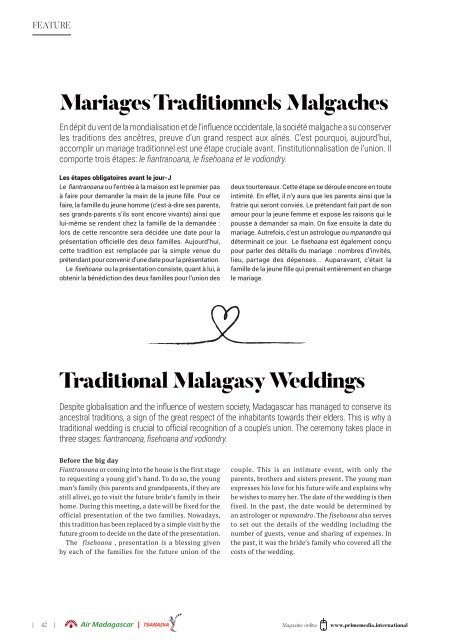Prime Magazine November 2020
You also want an ePaper? Increase the reach of your titles
YUMPU automatically turns print PDFs into web optimized ePapers that Google loves.
FEATURE<br />
Mariages Traditionnels Malgaches<br />
En dépit du vent de la mondialisation et de l’influence occidentale, la société malgache a su conserver<br />
les traditions des ancêtres, preuve d’un grand respect aux aînés. C’est pourquoi, aujourd’hui,<br />
accomplir un mariage traditionnel est une étape cruciale avant. l’institutionnalisation de l’union. Il<br />
comporte trois étapes: le fiantranoana, le fisehoana et le vodiondry.<br />
Les étapes obligatoires avant le jour-J<br />
Le fiantranoana ou l’entrée à la maison est le premier pas<br />
à faire pour demander la main de la jeune fille. Pour ce<br />
faire, la famille du jeune homme (c’est-à-dire ses parents,<br />
ses grands-parents s’ils sont encore vivants) ainsi que<br />
lui-même se rendent chez la famille de la demandée :<br />
lors de cette rencontre sera décidée une date pour la<br />
présentation officielle des deux familles. Aujourd’hui,<br />
cette tradition est remplacée par la simple venue du<br />
prétendant pour convenir d’une date pour la présentation.<br />
Le fisehoana ou la présentation consiste, quant à lui, à<br />
obtenir la bénédiction des deux familles pour l’union des<br />
deux tourtereaux. Cette étape se déroule encore en toute<br />
intimité. En effet, il n’y aura que les parents ainsi que la<br />
fratrie qui seront conviés. Le prétendant fait part de son<br />
amour pour la jeune femme et expose les raisons qui le<br />
pousse à demander sa main. On fixe ensuite la date du<br />
mariage. Autrefois, c’est un astrologue ou mpanandro qui<br />
déterminait ce jour. Le fisehoana est également conçu<br />
pour parler des détails du mariage : nombres d’invités,<br />
lieu, partage des dépenses... Auparavant, c’était la<br />
famille de la jeune fille qui prenait entièrement en charge<br />
le mariage.<br />
Traditional Malagasy Weddings<br />
Despite globalisation and the influence of western society, Madagascar has managed to conserve its<br />
ancestral traditions, a sign of the great respect of the inhabitants towards their elders. This is why a<br />
traditional wedding is crucial to official recognition of a couple’s union. The ceremony takes place in<br />
three stages: fiantranoana, fisehoana and vodiondry.<br />
Before the big day<br />
Fiantranoana or coming into the house is the first stage<br />
to requesting a young girl’s hand. To do so, the young<br />
man’s family (his parents and grandparents, if they are<br />
still alive), go to visit the future bride’s family in their<br />
home. During this meeting, a date will be fixed for the<br />
official presentation of the two families. Nowadays,<br />
this tradition has been replaced by a simple visit by the<br />
future groom to decide on the date of the presentation.<br />
The fisehoana , presentation is a blessing given<br />
by each of the families for the future union of the<br />
couple. This is an intimate event, with only the<br />
parents, brothers and sisters present. The young man<br />
expresses his love for his future wife and explains why<br />
he wishes to marry her. The date of the wedding is then<br />
fixed. In the past, the date would be determined by<br />
an astrologer or mpanandro. The fisehoana also serves<br />
to set out the details of the wedding including the<br />
number of guests, venue and sharing of expenses. In<br />
the past, it was the bride’s family who covered all the<br />
costs of the wedding.<br />
| 42 | <strong>Magazine</strong> online www.primemedia.international
















